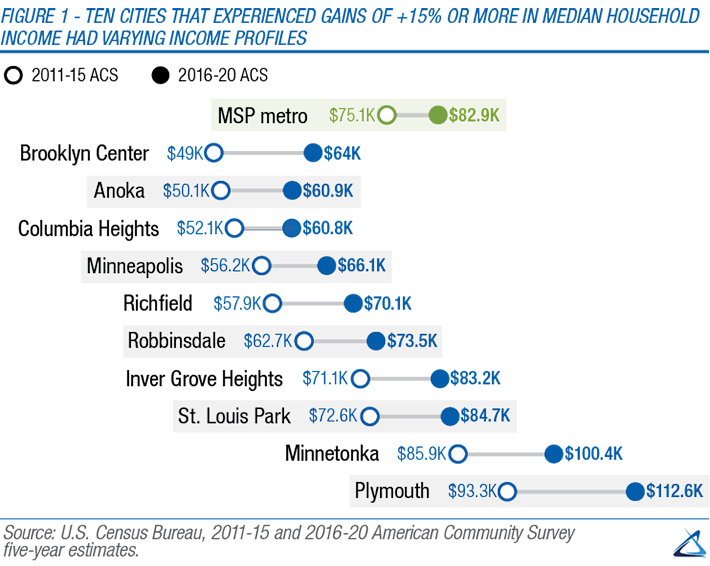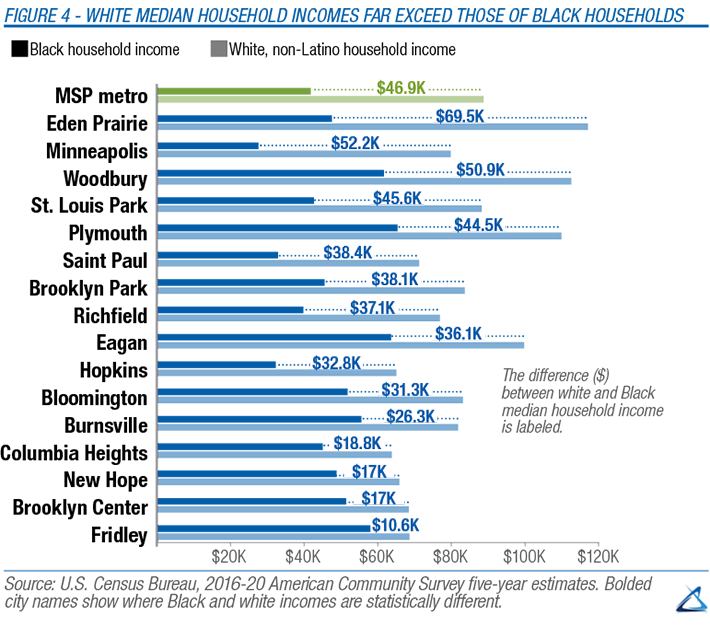New American Community Survey data released by the U.S. Census show that over the past decade, median household income increased by almost $8,000 (after inflation) in the 15-county Twin Cities metropolitan area. Many of the region’s cities saw even larger gains.
In several cities, lower-income households experienced the largest income gains, by percentage. Still, income inequality was largely unchanged between 2011-2015 and 2016-2020. In addition, large racial disparities in income exist across the region. In many cities, Black and Hispanic/Latino household incomes are far below white household incomes.

Gains for middle-income households
The 15-county Minneapolis-St. Paul (MSP) metro’s median household income increased by 10% between the first and second halves of the last decade, while 10 cities saw increases of more than 15%. These cities have widely varying income profiles, from Anoka's median household income of $64,000 in the 2016-2020 period to Plymouth's median household income of $112,600.
Gains shared across the income spectrum
The most recent American Community Survey data also show that the income gains over the decade were shared across the income spectrum. Lower-income households in the greater region saw slightly greater increases, 12.8%, than middle-income (10.3%) or higher-income households (10%). This held true for many individual cities as well.
Income inequality persists
Although household incomes at the lower end of the income distribution have increased more than those at the higher end, by percentage, overall income inequality did not change much between the 2011-15 and 2016-2020 periods. Only seven cities showed statistically significant changes in income inequality over the decade as measured by the Gini index, a widely used measure of inequality. Income inequality decreased in Burnsville, Coon Rapids, and Minneapolis, and increased in Blaine, Champlin, Ham Lake, and Maplewood.
The American Community Survey data also allow for a comparison of income trends for major race groups and those of Hispanic or Latino origin. Changes to the survey questionnaire and the processing of race data complicate comparisons between the two halves of the decade. But looking only at the 2016-2020 period, disparities by race are obvious.
These disparities are well-known at the regional level, but the new data reveal how they exist locally as well. Data interpreted by Met Council staff are from cities in the MSP metro with at least 1,000 households of the following groups (according to the 2020 Census): Black alone; Asian alone; Hispanic or Latino; and Native American alone.
Disparities for Black and white residents are larger than for any other major race group, with the median Black household in the MSP metro taking in $46,900 less than the median white household. Among all the cities with at least 1,000 Black households, Black median income is significantly lower than the white median. Even in many higher-income suburbs like Eden Prairie, Woodbury, and Plymouth, Black residents have dramatically lower median incomes than their white counterparts.
For the MSP metro, white residents and Asian residents have statistically similar levels of median income: $88,771 and $86,441, respectively. Further, among all cities with at least 1,000 Asian households, Asian and white median household incomes are statistically different only in Minneapolis and Saint Paul. The two central cities have the largest populations of Hmong, Vietnamese, or Karen residents, who tend to have lower incomes than other Asian populations in the region.
Clear evidence exists of disparities between Hispanic or Latino households and white households, though they are not as large as Black-white disparities. For the MSP metro area, the difference in median income is $27,100 between the two groups. The difference is even starker between Native American and white households: $40,700.

View Income Growth and Inequality in the Region’s Cities (PDF) for a fuller picture of the data.